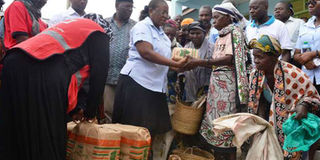Premium
More people to face starvation as food production drops

Kenya Ports Authority Managing Director Catherine Mturi-Wairi (centre) gives relief food to Maryango residents in Ganze Sub-County on October 28, 2016. Many Kenyans face starvation. PHOTO | KAZUNGU SAMUEL | NATION MEDIA GROUP
What you need to know:
- Last year alone, an estimated 1.3 million Kenyans faced starvation, according to the National Drought Management Authority.
- Laikipia, Kilifi and Kwale counties were most affected with approximately 580,000 people in dire need of food and water.
- The study reveals that Kenya’s current self-sufficiency ratio in staple food crops is just above 0.8.
More Kenyans are expected to face starvation due to low crop production occasioned by climate change, a study has revealed.
Last year alone, an estimated 1.3 million Kenyans faced starvation, according to the National Drought Management Authority.
Laikipia, Kilifi and Kwale counties were most affected with approximately 580,000 people in dire need of food and water.
The 2016 study by a group of scholars from Africa led by Martin van Ittersum titled Can Sub-Saharan Africa Feed Itself?, covered ten countries in the region (Burkina Faso, Ghana, Mali, Niger, Nigeria, Ethiopia, Kenya, Tanzania, Uganda, and Zambia) and looked at production of five major cereals — maize, millet, rice, sorghum, and wheat.
The study reveals that Kenya’s current self-sufficiency ratio in staple food crops is just above 0.8 which indicates a low cereal self-sufficiency ratio below the recommended ratio of 1.0 putting the country at risk of more starvation.
It further reveals that Kenya’s food self-sufficiency ratio is low compared to Eastern Africa country like Ethiopia which is near 1.0 and with expected boom in population growth and demand outstripping supply, the situation might get direr in the coming months.
AFFECT CROP PRODUCTION
The findings are supported by Kenya Meteorological Department which has warned that shortfall of rains experienced in the country might affect crop production, saying that the situation might get worse in the coming months.
Meanwhile, the Kenya Red Cross Society has began destocking livestock in Tana River County.
Hassan Musa, the society’s officer in charge of Coast region, said the first phase of the programme will involve purchase of 450 cattle and 246 goats and sheep.
Government statistics indicated that more than 120,000 herders have lost thousands of livestock of unknown value to drought in the county.
The society will conduct the programme worth Sh7.5 million in the three sub-counties of Tana, namely, Tana North, Tana River and Tana Delta.
The programme involves buying livestock directly from farmers, slaughtering them and distributing the meat to drought victims in the area.
Mr Musa said they would implement the programme in all areas affected by the drought. On Tuesday, Red Cross officials visited Merti village in Hirimani location, which is one of hard hit areas.






